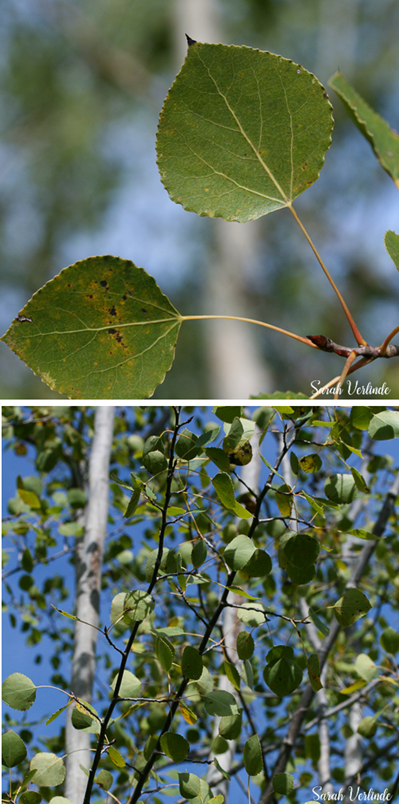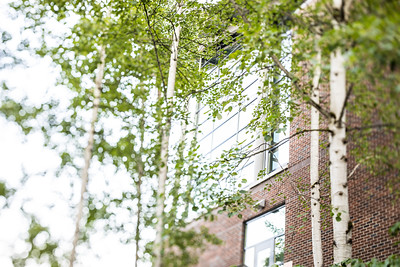Quaking aspen
Populus tremuloides – Quaking aspen
Morphology

- Family: Salicaceae
- Plant Type: deciduous, tall, erect tree
- Height: 45 feet tall
- Bark: greenish-gray and feels smooth. Older trees have black-dark gray bark and can be somewhat rough.
- Notable feature: the stem between the leaf and the branch is called a petiole. When rolled in between your thumb and finger, this is flat, rather than round. Because of this feature, the wind causes the leaves to appear to shake or tremble, which is why the tree is called “quaking” aspen, and the latin name is P. tremuloides (trem-ble). Please note, there is also a Populus tremula stand on campus, the European aspen, which also has a flat petiole but has a larger leaf and has a more coarsely toothed margin.
Distribution and Habitat
- Distribution: Most widely distributed tree in North America.
- Habitat: In Washington state, this tree can be found along wetlands, stream sides, lake shores, and rocky, well-drained soils too. Full sun to partial shade.
Reproduction
- Flowers/Fruits: drooping catkins, green to dark red/brown in color with white hairs.
- Flowering Season: April – June
- Leaves: round to ovate shape with short pointed (acuminate) tips and a finely toothed and hairy margin. Alternately arranged. Colors tend to be a pale green and turn into bright yellows and oranges in the fall.
- Generation: Perennial
Restoration and Conservation Applications
Quaking aspen is a good plant for restoration purposes. It has the ability to grow quickly in a variety of moisture, soil, and light conditions. It makes a great early succession plant and will often move into an area once the area is cleared by flooding or fire. This tree has a wide distribution across the nation because it is well adapted for challenges. The leaves have phenolic compounds that deter insects from herbivory. In wetland areas, mature quaking aspens respond well to beavers that chop them down. Afterward, the trees are able to send up suckers, or spread rhizomatously (by spreading sending out shoots nearby), looking more like a shrub than a tree. The trees not only feed beavers, but the flowers feed pollinators and the foliage makes good browse for bear, deer, and elk. It also provides habitat for many birds and small mammals.

Ethnobotany and plant uses
In the United States, P. tremuloides is used for timber, paper pulp, and is used for sauna benches. This tree contains compounds, salicylates that help with anti-inflammatory purposes. Native tribes used to drink a tea of the bark, or use a poultice to apply to sore joints or cuts. It was even used for pain relief during childbirth. The inner bark has been dried and ground into a powder, used in a similar manner as wheat baking flour for bread or thickening soups.
Plant References and Resources
- WTU Image Herbarium: http://biology.burke.washington.edu/herbarium/imagecollection/taxon.php?Taxon=Populus%20tremuloides
- Lindroth, RL, Osier, TL, Barnhill, HRH, and Wood, SA. 2002. Effects of genotype and nutrient availability on phytochemistry of trembling aspen (Populus tremuloides Michx.) during leaf senescence. Biochemical Systematics and Ecology. 30: 297-307.
- Perala, DA. Populus tremuloides [Internet]. c2014 [cited 2014 Dec 07]. Available from: http://www.na.fs.fed.us/pubs/silvics_manual/volume_2/populus/tremuloides.htm
- PFAF: Plants for a future [Internet]. c1996-2012 [cited 2014 Dec 07]. Available from: https://pfaf.org/user/Plant.aspx?LatinName=Populus+tremuloides
- USDA: Plant characteristics [Internet]. c2014 [cited 2014 Oct 19- Dec 08]. Available from: http://plants.usda.gov/
This article was written by Sarah Verlinde. For questions regarding the UWB/CC Plant Tour, contact Sarah at severlin@uw.edu.